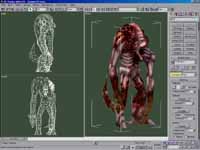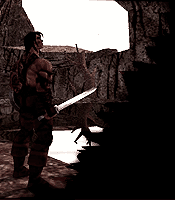|
3d Artist: Luis Miguel Quijada
Before I joined RAS and came to Madrid I was
finishing my Computer Science degree in Granada. I had not worked
for any other commercial project before, but I had been working
with many graphic design programs under different computers and
O.S. I started working here because one of my friends (Manuel Ruiz),
who already worked here and loved Videogames as much as me, told
them about me.
 I've
been a fan of Synthetic Image contests and expositions such as Imagina
or Sigraph for a long time, where I could admire the works of people
or companies such as Pixar. The definitive interest in 3d art started
when I saw the dinosaurs in Jurassic Park. I've
been a fan of Synthetic Image contests and expositions such as Imagina
or Sigraph for a long time, where I could admire the works of people
or companies such as Pixar. The definitive interest in 3d art started
when I saw the dinosaurs in Jurassic Park.
The monster in this picture is a Minor Demon.
The bigger problem we had with it was animating it, because it is
not symmetrical and it doesn't have human proportions, which made
it impossible to use motion capture for it.
We start by sketching a pencil design of the
model, which is used as a base for the mesh modeling under 3dsMax.
It is then limited in its number of polygons to a value manageable
for the engine in the game.
Although there are some previous pencil drawings
I do not need to use them as background to trace the model, I just
follow the drawing and this gives me the freedom to improvise depending
on how the mesh is behaving.
Generally I start creating a Primitive in MAX
(Sphere, cylinder...) that I modify in a low level, extruding faces,
cutting edges and moving vertices. I do not often model different
parts separately, except to build armours and certain models.
Once we have a mesh and have prepared the skeleton
& pivots of the model, comes the most difficult part of the
work: texturing. It is an absolutely artisan work dividing parts
of the mesh and applying to them the texture taking care to avoid
discontinuities at the joints. We work here with Photoshop because
using layers helps us a lot.
The last part is defining the hurt zones, which
use alternative wounds textures, preparing the limbs to be sliced
for mutilations and then a whole lot of technical stuff that will
make the model work correctly.
We use no Plug-ins for modeling, texturing
or animating that allows us to create a character in five minutes
(does such a thing exist?). That means hours of hard work in MAX
and Photoshop until a character is ready for the engine. But it's
a very creative and rewarding work.
The texture size is 256x256 true color, which
gets reduced to 256 colors, generated automatically by our own program
from the textures processed in it and generated by Photoshop. So
we do not have great limitations in the use of palettes. We can
use as many palettes as we need (most of the times one per character).
There is also no limit for the number of textures a model can have,
though they are usually two.
There is not a general heuristic; each model
has to be approached from zero attending to its own characteristics
that will make it different from the others. Of course we have to
be very careful about the curved zones (both in characters and objects)
for they need a huge number of polys that may be useful for others
parts of the model... anyone thinking about the Amazon?
The model is composed of three parallel structures
that give the engine different information. One tells the engine
about the skin and the hurting zones, another gives the pivots &
skeleton data and the last one describes the mutilations. All this
works as a single entity giving additional information different
from the mesh to be used at low level in the engine.
There are lots of characteristics the engine
needs to know about an object to make it behave properly. All this
is part of the amazing and colorful world of thousands of text files
where endless lists of data are defined (weight, significance, category
of object etc...).
There are different versions of the orcs' and
knight's textures in order to "redefine" these enemies
in more advanced levels, being tougher than the previous versions
and make them appear more fierce. This way, for example the orcs,
in the initial levels will turn to be in higher levels Dark Orcs
which are more dangerous... because obviously the player will have
reached a higher level too than when he began.
Each character has certain types of armour
only he can use. There are different models for each stage of armour
to show the change. That is, for example, the amazon will not be
able to use any of the knight's amours but will use her specific
ones, varying the model for each of the armours she's wearing.
The system to make a High poly model is radically
different (we are talking about models with more than 150000 polys).
Patches and Nurbs are usually used and even tessellated versions
of low poly models so that the resemblance between them would be
the highest possible. In addition each element of the clothes that
in the low poly model that was textured has to be modeled separately.
The final-enemies, in Blade, have about 2000 polys and 200 for the
most complex weapon.
Previous
| Index | Next
|





